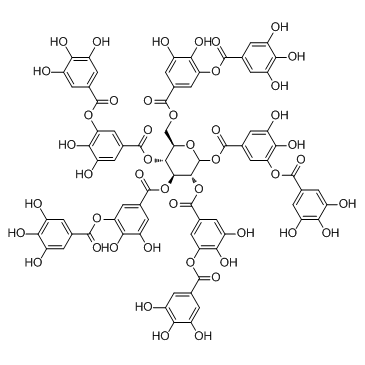Tannic acid

Tannic acid structure
|
Common Name | Tannic acid | ||
|---|---|---|---|---|
| CAS Number | 1401-55-4 | Molecular Weight | 1701.198 | |
| Density | 2.1±0.1 g/cm3 | Boiling Point | N/A | |
| Molecular Formula | C76H52O46 | Melting Point | 218 °C(lit.) | |
| MSDS | Chinese USA | Flash Point | 198°C | |
Use of Tannic acidTannic acid is a novel hERG channel blocker with IC50 of 3.4 μM. |
| Name | tannic acid |
|---|---|
| Synonym | More Synonyms |
| Description | Tannic acid is a novel hERG channel blocker with IC50 of 3.4 μM. |
|---|---|
| Related Catalog | |
| Target |
IC50: 3.4 μM (hERG channel)[1] |
| In Vivo | During the course of treatment, tannic acid significantly ameliorates these phenotypes in AD skin lesions. Tannic acid treatment aslo reduces these dermal changes compare with AD mice. Treatment with tannic acid increases PPARγ expression in AD skin sections. The PPARγ protein expression is suppressed in vehicle-treated AD mice, but when treats with tannic acid, its expression is increased dramatically. The IL-1β, TNFα, TNFR1, and COX2 protein expressions are significantly up-regulated in vehicle-treated AD mice, but significantly suppressed by tannic acid treatment[2]. |
| Animal Admin | Specific pathogen-free female 6 weeks old mice are used. The animals are maintained in a controlled room (temperature 23±2 °C, humidity 55±15%, 12 h light cycle). After 1 week, the mice arer andomly divided into 3 groups, untreated group-receive vehicle (distill water) (Normal, n=5); DfE cream treated mice (100 mg/mouse) is divided into two groups and each receives vehicle (distill water) (AD, n=5) or Tannic acid (80 mg/kg/day, per oral) (AD+Tannic acid, n=5) and are allowed free access to drinking water and standard laboratory diet[2]. |
| References |
| Density | 2.1±0.1 g/cm3 |
|---|---|
| Melting Point | 218 °C(lit.) |
| Molecular Formula | C76H52O46 |
| Molecular Weight | 1701.198 |
| Flash Point | 198°C |
| Exact Mass | 1700.172974 |
| PSA | 777.98000 |
| LogP | 13.33 |
| Index of Refraction | 1.927 |
| Stability | Stable. Incompatible with metallic salts, strong oxidizing agents, iron and other heavy metals. |
| Water Solubility | 250 g/L (20 ºC) |
CHEMICAL IDENTIFICATION
HEALTH HAZARD DATAACUTE TOXICITY DATA
|
| Hazard Statements | H412 |
|---|---|
| Precautionary Statements | P273 |
| Personal Protective Equipment | Eyeshields;Gloves;type N95 (US);type P1 (EN143) respirator filter |
| Hazard Codes | Xi: Irritant; |
| Risk Phrases | R40 |
| Safety Phrases | 24/25-36-26-36/37/39-22 |
| RIDADR | NONH for all modes of transport |
| WGK Germany | 2 |
| RTECS | WW5075000 |
| HS Code | 3201909000 |
| HS Code | 3201909000 |
|---|
|
Brief reports: Lysosomal cross-correction by hematopoietic stem cell-derived macrophages via tunneling nanotubes.
Stem Cells 33(1) , 301-9, (2014) Despite controversies on the potential of hematopoietic stem cells (HSCs) to promote tissue repair, we previously showed that HSC transplantation could correct cystinosis, a multisystemic lysosomal st... |
|
|
Chemical profile and in vivo hypoglycemic effects of Syzygium jambos, Costus speciosus and Tapeinochilos ananassae plant extracts used as diabetes adjuvants in Puerto Rico.
BMC Complement Altern. Med. 15 , 244, (2015) The increasing numbers of people who use plant-based remedies as alternative or complementary medicine call for the validation of less known herbal formulations used to treat their ailments. Since Pue... |
|
|
Low molecular weight procyanidins from grape seeds enhance the impact of 5-Fluorouracil chemotherapy on Caco-2 human colon cancer cells.
PLoS ONE 9(6) , e98921, (2014) Grape seed procyanidins (PC) are flavan-3-ol oligomers and polymers known for their biological activity in the gut. Grape seed extract (GSE) have been reported to reduce intestinal injury in a rat mod... |
| Tannic acid |
| Gallotannin,Tannin |
| MFCD00066397 |
| EINECS 215-753-2 |
| Gallotannin Tannin |
| Glycerite |

